Resolving customer complaints in the digital era
Telcos: Dare to care ?


2
Customer complaints management – Why is it a big deal?
Across the telco customer life cycle, receiving service (the “gethelp” step) is arguably the most critical driver of satisfaction or dissatisfaction – and it is directly impacted by the agility and effectiveness of underlying processes. Furthermore, from a customer perspective, getting timely and effective assistance with service disruption issues is critical to maintaining the connection with, and confidence in, the brand. Telcos have several potential product/service/process fracture points across their customers’ life cycle, which may require a resolution from the operator.
However, operators face challenges in two key aspects – 1) high volume of complaints and 2) long cycle times for redressal of complaints.
- High volume of complaints: A telco’s customer-complaints incidence (defined as the number of customer complaints per 1,000 customers) is driven by the complexity of products and services and the processes underlying customer journeys. Despite sustained efforts (product and service audits, simulations, journey testing, etc.) and advances in technology, reducing complaints volume remains a challenge for telcos. Our global benchmark indicates that a typical telecom operator’s customer raises more than twice the number of complaints as those of the industry best-in-class.
- Long cycle time for complaints resolution: Telecom operators struggle to resolve customer complaints quickly. Our experience indicates that a typical operator promises to resolve complaints in three working days, but manages to do so in, at best, only 70 percent of cases. In fixed services, this performance is even worse due to the additional challenges around field operations and interfaces with wholesale infrastructure providers.
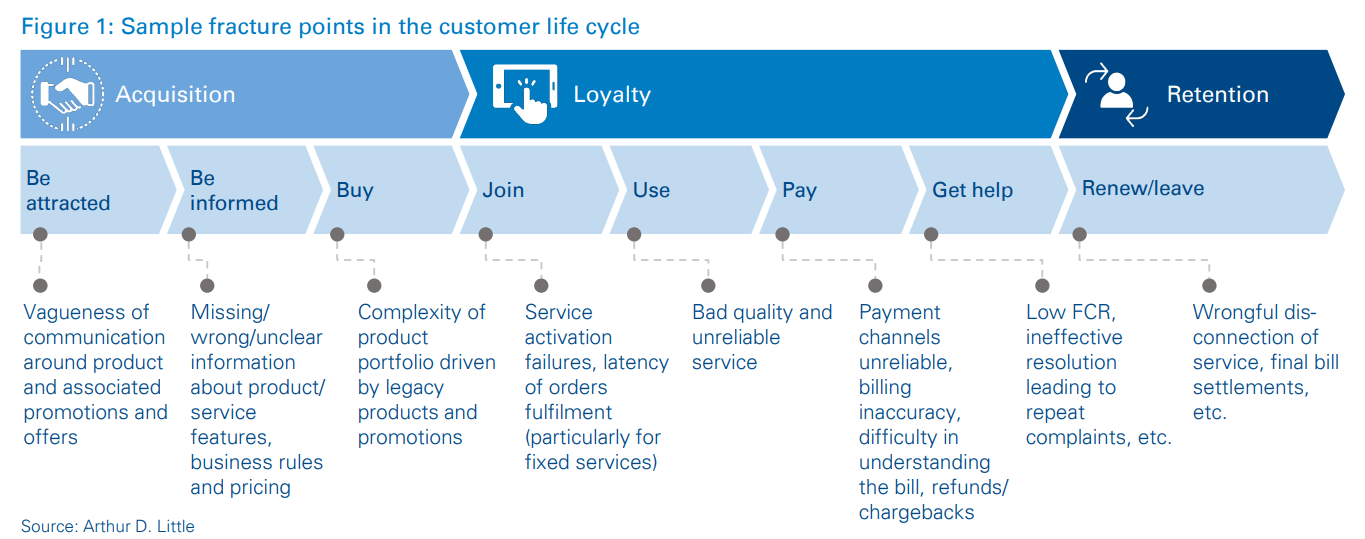
The speed of resolution is driven by the end-to-end design of the complaints management factory – i.e., the operational set-up of handling a customer complaint from the time it is raised until the resolution. There are three key factors which typically result in delays in customer complaint resolution.
- Gaps in complaints management factory: Typically, telcos have back offices to handle customer complaints which can’t be addressed by self-service and front-line channels (call center, retail, etc.). Depending on their concentration levels of accountability, authority, etc., telcos have other functions, such as finance and network/technology, that also play critical roles in complaints resolution. A key driver for slow speed of resolution is inefficiencies in the operational design of interfaces between various factory components and gaps in factory operating model (i.e. organization structure, governance/steering, capacity or skills of agents, field operations, and other supporting functions).
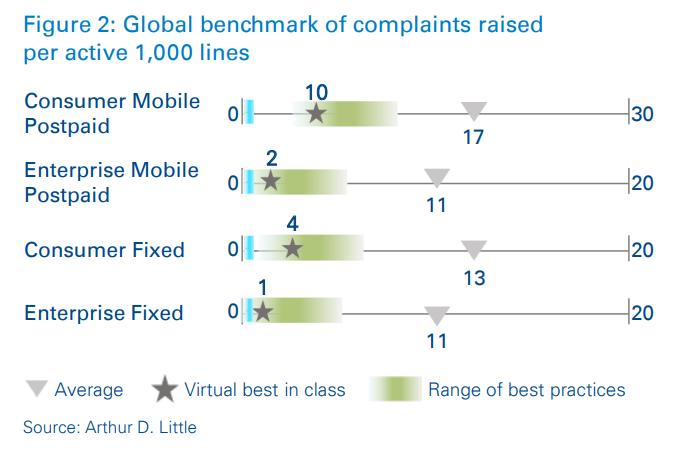
- Poor partner management
- Ineffective steering of outsourcing partner(s): Partners used for outsourcing some of the complaints-handling steps are usually not steered effectively for continuous performance improvements resulting in resolution performance stagnation.
- Non-optimal customer operations sourcing model: Non-optimal outsourcing of back-office operations, as well as poor relationships with front-office partner(s) and those in other supporting functions (e.g., IT and network operations) often slow things down.
- Misaligned SLA/OLA targets and performance: Typically, service-level agreements (SLAs) are misaligned with customer expectations, there is not enough endto-end SLA accountability, operational-level agreements (OLAs) are not aligned with end-to-end SLAs, and handover delays between complaints-resolving groups are not accounted for in SLAs and OLAs, which all results in delays in customer complaint resolution
- Process Flaws
- Process bottlenecks: There is usually handover friction (or “ping-pong”) between resolving groups, and the lack of information flow across the process creates critical delays.
- Lack of digitalization/automation: Lack of automation across the complaints management process, nonsynchronized data structure across systems (to capture all the attributes of complaints), and white spots in system capabilities limit resolution speed.
- Flawed complaint prioritization and channelization logic: Process flaws such as misalignment with customer expectations, customer value not having been considered across all units in the process, faulty logic in assigning complaints to resolving groups, lack of clarity on ownership, an ineffective escalation matrix, and a purely technical perspective for priority setting also result in long complaints-resolution cycle time.
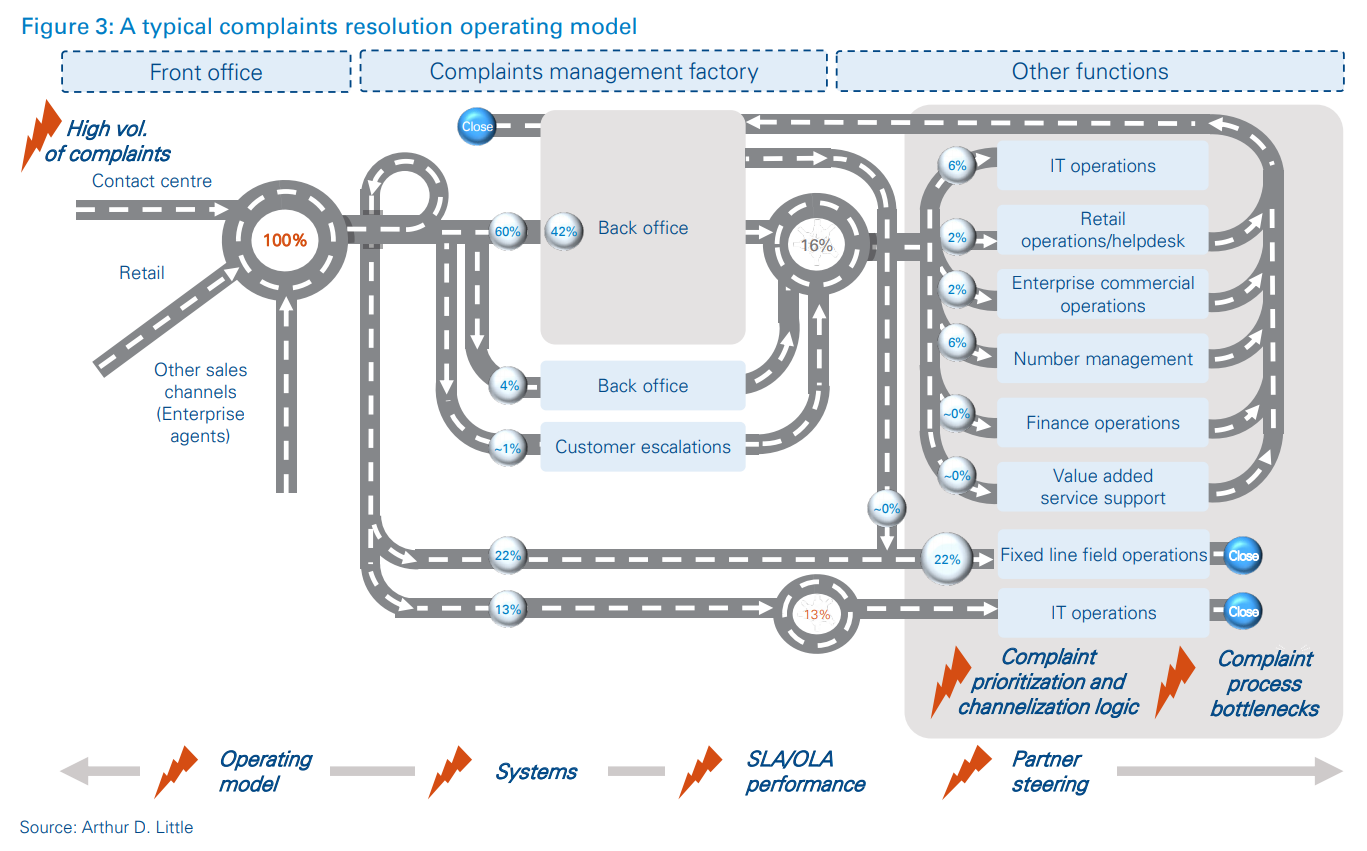
3
Radical transformation of customer complaints management – Is it realistic?
Arthur D. Little has deep expertise in customer experience transformations in general, and customer complaints management in particular. We apply a data-driven, practical methodology to assess telcos’ performance vis-à-vis industry peers and beyond, to realign ambitions and targets with the aim of delivering a differentiating experience. Most importantly, we devise operational transformations and know how to execute them working side by side with clients.
As highlighted in the below case study, we believe radical transformation programs are possible and bring satisfactory results
Case study: Radical transformation of the complaints management process for volume reduction and faster resolution
Arthur D. Little conducted a holistic, in-depth assessment of the root causes behind the sub-optimal complaints resolution performance of a challenger (integrated) operator. A global benchmark analysis, which included both converged telcos in the market and leading service providers from other sectors, highlighted that the operator’s complaint resolution targets were not ambitious enough and performance was far lower than average or best-in-class service levels. Therefore, a complaint management model transformation was recommended, with the objective of significantly reducing resolution cycle time and complaint incidence.
Arthur D. Little used a comprehensive set of levers to revamp the complaints management operating model. This resulted in several milestones beyond significant complaint SLA performance enhancement. We:
- Leveraged big data analytics to identify gaps and inefficiencies across the operating model;
- Incorporated complaints resolution SLA performance as a KPI in executive scorecards;
- Redesigned the steering model for managed services partners in back-office operations, with tighter SLAs and performance-linked bonuses;
- Designed and implemented OLAs to steer and uplift the performance of supporting functions in the factory;
- Redesigned the operating model of specific supporting functions for greater accountability and capability, which would result in sustained performance improvement;
- Leveraged artificial intelligence (AI), machine learning (ML) and robotic process automation (RPA) extensively to reimagine the complaint management processes, which reduced both complaints volume and resolution time. For example:
- Reimagined specific processes with robotics, which led to elimination of approximately 10 percent of customer complaints, and is expected to reduce up to 20 percent in the near future;
- Incorporated AI-driven predictive ticketing;
- Introduced chatbots for both front- and back-office agents, which helped them resolve complaints faster;
- Implemented automated executive dashboards so management could see complaints resolution performance.
As a result:
- The client drastically improved its performance in customer complaints resolution, from 65 percent of complaints resolved within two days to 86 percent in the same amount of time.
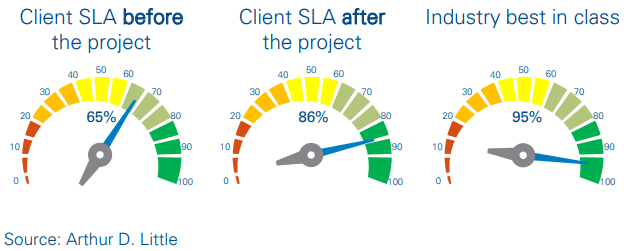
- Additionally, a roadmap to lift this to 95 percent resolution within two days was recommended, with a set of actions and levers to continuously improve the performance, and set a new benchmark in customer complaints resolution in the market.
4
Best-practice design principles for customer complaints management model
What are best-practice design principles for customer complaints management model?
Arthur D. Little recommends some key design principles for telcos to attain a robust customer complaints management model and achieve radical performance improvements:
- Reorient the accountability towards delivering a differentiating customer experience: The operating model must ensure accountability for both incidence and resolution of complaints by institutionalizing appropriate KPIs and targets across organization structure levels. This creates a culture of customer-centricity and moves away from the mind-set that customer experience solely relies on the front-office team. A typical approach for such a reorientation entails:
- Identification of the most impactful strategic and operational KPIs related to complaints management, such as volume reduction and resolution speed;
- Allocation of meaningful weight to these KPIs and targets at executive and management levels by adding those KPIs (such as Net Promoter Score – NPS/customer service – CSAT/customer satisfaction index – CSI) to management scorecards (L1 layer);
- Cascading and contextualizing operational KPIs and targets (e.g., tNPS, first contact resolution – FCR) from L2 to L4 layers of the complaints management factory.
- Consolidate the complaints management factory with minimal external dependencies to create a single point of accountability for end-to-end complaints resolution. Such consolidation can be achieved through organizational changes and technology empowerments. Ensure accountability among departments by setting up interdepartmental OLAs.
- Structure the complaints management factory with dedicated groups: for specific high-value segments to bring the appropriate focus; for technical issues (e.g., fixed services) that require particular skill sets; and lastly, for specific scenarios of aging (e.g., long-overdue complaints) to avoid escalation of complaints in the long tail
- Simplify complaints management processes by initiatives such as:
- Front-load complaints management, aiming to resolve complaints in the first instance (first call/first visit resolution – FCR/FVR) by empowering front-line staff and equipping them with knowledge management portals and tools.
- Install a feedback loop for continuous improvement. Ensure complaint types and their resolution are recorded to minimize or automate solving of similar complaints that may come up in future.
What are the possibilities through Digitalization?
Most leading digital players have incorporated AI-driven applications such as chatbots, automated agent pairing, and predictive routing for their complaints management. Telcos should follow suit:
- Leverage technology such as bots and predictive ticketing to forecast future customer complaints and solve potential issues before they are raised.
- Digitalize and automate processes across the complaints life cycle through AI, ML and RPA.
- Move to paperless contracts with e-signatures/biometrics to avoid errors.
- Adopt a single CRM system for complaints management, which will provide the agent with the detailed history of the customer, even before picking up the call, and allow them to meet the customer’s needs with more skill and professionalism.
- Automate tasks across the complaints life cycle, such as:
- Segmentation/prioritization of complaints, based on complaint type, customer value, complaint urgency, etc.;
- Forwarding to the right resolver group/agent;
- Workflow management and monitoring of complaints progress.
- Simplify and reimagine procedures by leveraging RPA.
- RPA mirrors human software interaction to take over administrative and repetitive activities. It is characterized by high applicability and speed of implementation, while enabling cost and other process improvement benefits. However, as seen in reality, most telcos are still at the beginning of leveraging the full potential of RPA. To scale RPA right, they need to establish an agile operating model that has been integrated with their existing business and IT processes.
What about the customer operations sourcing model dilemma?
Telcos need to consider hybrid sourcing models with mixes of insourced and outsourced approaches, as well as strong management and partner incentives for better quality and performance. In doing so, operators should retain control of some segments/functions and outsource others to specialized partners, as the overall sourcing strategy must strike a balance between quality, cost and control.
The steering model for outsourcing partners should:
- Link partners’ SLA performances to incentive and penalty mechanisms, appreciating good performances while penalizing inefficiency;
- Ensure outsourcing partners’ KPIs are aligned with process objectives, with incentives linked to improvements in process performance;
- Work proactively with partners to develop skills and knowledge regarding upcoming products and services in the back office for quick ramp-up;
- Drive insourced functions’ performance by implementing OLAs.
Case study: Reduction of complaints incidence – Process simplification through robotic process automation
Arthur D. Little helped a telco client leverage RPA for instant resolution of service requests. The results were significantly enhanced customer experience and massive savings.
Before the RPA implementation, the SIM reactivation journey comprised five steps that took three days or more, and required the customer to make at least two physical visits to the retail store.
After implementation of RPA, the SIM reactivation customer journey took only one store visit and the customer request was resolved within minutes, without any need to raise a trouble ticket.
As a result:
- All SIM activation requests (accounting for thirty-three percent of all requests/complaints raised in the retail channel) were resolved instantly, which thus eliminated the load on the back office and freed them up to resolve the remaining volume faster.
- Moreover, it led to an enhanced customer experience through instant resolution and avoidance of the second store visit.
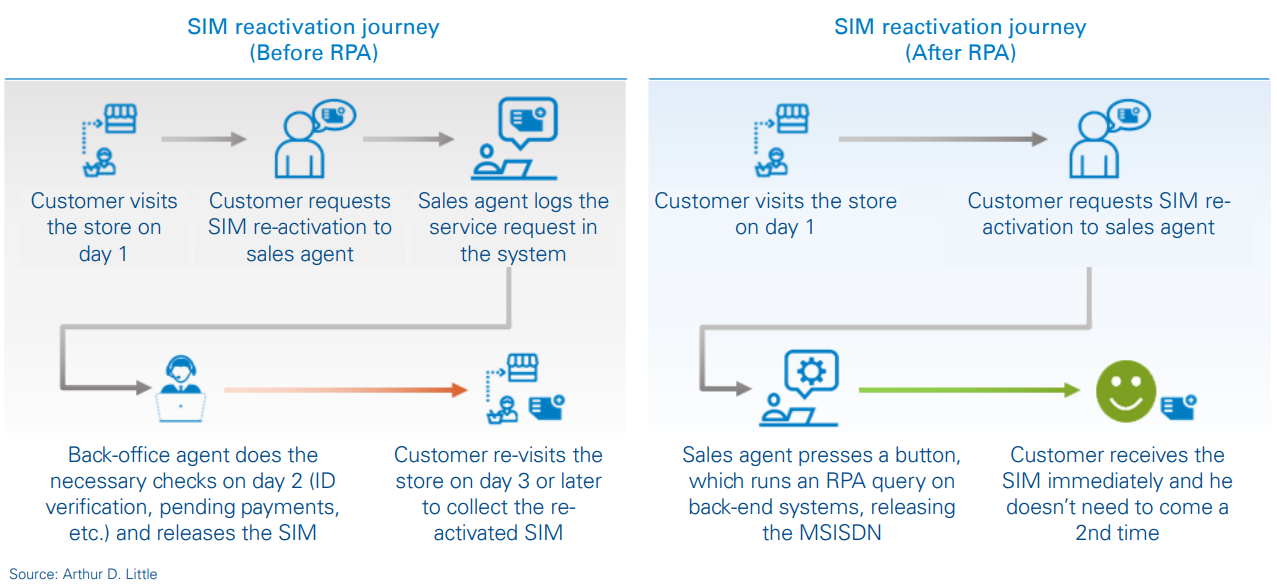
5
Recommendations
Telcos must proactively address the long-overlooked topic of customer complaints management, placing it at the center of their customer experience transformation efforts. Specifically, customer experience executives should undertake the following levers to design a best-in-class complaints management factory
- Benchmark: Benchmark your complaints management performance (incidence and resolution) against industry peers and digital-native players.
- Reset: Based on benchmarking and as-is diagnostics, uplift your customer experience ambition and translate it into complaint incidence and resolution KPI targets, to differentiate your company from competition.
- Diagnose: Assess the as-is complaints management factory to identify structural bottlenecks or issues that may exist around key areas such as governance, operating model, sourcing model, process design, and digitalization.
- Reimagine: Reimagine the complaints management factory design with consolidated accountability and seamless interfaces across units and supporting functions.
- Be bold: Don’t hesitate to consider radical changes in the sourcing strategy, partner incentives, and management incentives.
- Innovate: Leverage technology to streamline the complaints life cycle, realizing the best-practice actions listed above, and digitalize and automate processes across the life cycle through AI, ML and RPA.
DOWNLOAD THE FULL REPORT
Resolving customer complaints in the digital era
Telcos: Dare to care ?

DATE

2
Customer complaints management – Why is it a big deal?
Across the telco customer life cycle, receiving service (the “gethelp” step) is arguably the most critical driver of satisfaction or dissatisfaction – and it is directly impacted by the agility and effectiveness of underlying processes. Furthermore, from a customer perspective, getting timely and effective assistance with service disruption issues is critical to maintaining the connection with, and confidence in, the brand. Telcos have several potential product/service/process fracture points across their customers’ life cycle, which may require a resolution from the operator.
However, operators face challenges in two key aspects – 1) high volume of complaints and 2) long cycle times for redressal of complaints.
- High volume of complaints: A telco’s customer-complaints incidence (defined as the number of customer complaints per 1,000 customers) is driven by the complexity of products and services and the processes underlying customer journeys. Despite sustained efforts (product and service audits, simulations, journey testing, etc.) and advances in technology, reducing complaints volume remains a challenge for telcos. Our global benchmark indicates that a typical telecom operator’s customer raises more than twice the number of complaints as those of the industry best-in-class.
- Long cycle time for complaints resolution: Telecom operators struggle to resolve customer complaints quickly. Our experience indicates that a typical operator promises to resolve complaints in three working days, but manages to do so in, at best, only 70 percent of cases. In fixed services, this performance is even worse due to the additional challenges around field operations and interfaces with wholesale infrastructure providers.

The speed of resolution is driven by the end-to-end design of the complaints management factory – i.e., the operational set-up of handling a customer complaint from the time it is raised until the resolution. There are three key factors which typically result in delays in customer complaint resolution.
- Gaps in complaints management factory: Typically, telcos have back offices to handle customer complaints which can’t be addressed by self-service and front-line channels (call center, retail, etc.). Depending on their concentration levels of accountability, authority, etc., telcos have other functions, such as finance and network/technology, that also play critical roles in complaints resolution. A key driver for slow speed of resolution is inefficiencies in the operational design of interfaces between various factory components and gaps in factory operating model (i.e. organization structure, governance/steering, capacity or skills of agents, field operations, and other supporting functions).

- Poor partner management
- Ineffective steering of outsourcing partner(s): Partners used for outsourcing some of the complaints-handling steps are usually not steered effectively for continuous performance improvements resulting in resolution performance stagnation.
- Non-optimal customer operations sourcing model: Non-optimal outsourcing of back-office operations, as well as poor relationships with front-office partner(s) and those in other supporting functions (e.g., IT and network operations) often slow things down.
- Misaligned SLA/OLA targets and performance: Typically, service-level agreements (SLAs) are misaligned with customer expectations, there is not enough endto-end SLA accountability, operational-level agreements (OLAs) are not aligned with end-to-end SLAs, and handover delays between complaints-resolving groups are not accounted for in SLAs and OLAs, which all results in delays in customer complaint resolution
- Process Flaws
- Process bottlenecks: There is usually handover friction (or “ping-pong”) between resolving groups, and the lack of information flow across the process creates critical delays.
- Lack of digitalization/automation: Lack of automation across the complaints management process, nonsynchronized data structure across systems (to capture all the attributes of complaints), and white spots in system capabilities limit resolution speed.
- Flawed complaint prioritization and channelization logic: Process flaws such as misalignment with customer expectations, customer value not having been considered across all units in the process, faulty logic in assigning complaints to resolving groups, lack of clarity on ownership, an ineffective escalation matrix, and a purely technical perspective for priority setting also result in long complaints-resolution cycle time.

3
Radical transformation of customer complaints management – Is it realistic?
Arthur D. Little has deep expertise in customer experience transformations in general, and customer complaints management in particular. We apply a data-driven, practical methodology to assess telcos’ performance vis-à-vis industry peers and beyond, to realign ambitions and targets with the aim of delivering a differentiating experience. Most importantly, we devise operational transformations and know how to execute them working side by side with clients.
As highlighted in the below case study, we believe radical transformation programs are possible and bring satisfactory results
Case study: Radical transformation of the complaints management process for volume reduction and faster resolution
Arthur D. Little conducted a holistic, in-depth assessment of the root causes behind the sub-optimal complaints resolution performance of a challenger (integrated) operator. A global benchmark analysis, which included both converged telcos in the market and leading service providers from other sectors, highlighted that the operator’s complaint resolution targets were not ambitious enough and performance was far lower than average or best-in-class service levels. Therefore, a complaint management model transformation was recommended, with the objective of significantly reducing resolution cycle time and complaint incidence.
Arthur D. Little used a comprehensive set of levers to revamp the complaints management operating model. This resulted in several milestones beyond significant complaint SLA performance enhancement. We:
- Leveraged big data analytics to identify gaps and inefficiencies across the operating model;
- Incorporated complaints resolution SLA performance as a KPI in executive scorecards;
- Redesigned the steering model for managed services partners in back-office operations, with tighter SLAs and performance-linked bonuses;
- Designed and implemented OLAs to steer and uplift the performance of supporting functions in the factory;
- Redesigned the operating model of specific supporting functions for greater accountability and capability, which would result in sustained performance improvement;
- Leveraged artificial intelligence (AI), machine learning (ML) and robotic process automation (RPA) extensively to reimagine the complaint management processes, which reduced both complaints volume and resolution time. For example:
- Reimagined specific processes with robotics, which led to elimination of approximately 10 percent of customer complaints, and is expected to reduce up to 20 percent in the near future;
- Incorporated AI-driven predictive ticketing;
- Introduced chatbots for both front- and back-office agents, which helped them resolve complaints faster;
- Implemented automated executive dashboards so management could see complaints resolution performance.
As a result:
- The client drastically improved its performance in customer complaints resolution, from 65 percent of complaints resolved within two days to 86 percent in the same amount of time.

- Additionally, a roadmap to lift this to 95 percent resolution within two days was recommended, with a set of actions and levers to continuously improve the performance, and set a new benchmark in customer complaints resolution in the market.
4
Best-practice design principles for customer complaints management model
What are best-practice design principles for customer complaints management model?
Arthur D. Little recommends some key design principles for telcos to attain a robust customer complaints management model and achieve radical performance improvements:
- Reorient the accountability towards delivering a differentiating customer experience: The operating model must ensure accountability for both incidence and resolution of complaints by institutionalizing appropriate KPIs and targets across organization structure levels. This creates a culture of customer-centricity and moves away from the mind-set that customer experience solely relies on the front-office team. A typical approach for such a reorientation entails:
- Identification of the most impactful strategic and operational KPIs related to complaints management, such as volume reduction and resolution speed;
- Allocation of meaningful weight to these KPIs and targets at executive and management levels by adding those KPIs (such as Net Promoter Score – NPS/customer service – CSAT/customer satisfaction index – CSI) to management scorecards (L1 layer);
- Cascading and contextualizing operational KPIs and targets (e.g., tNPS, first contact resolution – FCR) from L2 to L4 layers of the complaints management factory.
- Consolidate the complaints management factory with minimal external dependencies to create a single point of accountability for end-to-end complaints resolution. Such consolidation can be achieved through organizational changes and technology empowerments. Ensure accountability among departments by setting up interdepartmental OLAs.
- Structure the complaints management factory with dedicated groups: for specific high-value segments to bring the appropriate focus; for technical issues (e.g., fixed services) that require particular skill sets; and lastly, for specific scenarios of aging (e.g., long-overdue complaints) to avoid escalation of complaints in the long tail
- Simplify complaints management processes by initiatives such as:
- Front-load complaints management, aiming to resolve complaints in the first instance (first call/first visit resolution – FCR/FVR) by empowering front-line staff and equipping them with knowledge management portals and tools.
- Install a feedback loop for continuous improvement. Ensure complaint types and their resolution are recorded to minimize or automate solving of similar complaints that may come up in future.
What are the possibilities through Digitalization?
Most leading digital players have incorporated AI-driven applications such as chatbots, automated agent pairing, and predictive routing for their complaints management. Telcos should follow suit:
- Leverage technology such as bots and predictive ticketing to forecast future customer complaints and solve potential issues before they are raised.
- Digitalize and automate processes across the complaints life cycle through AI, ML and RPA.
- Move to paperless contracts with e-signatures/biometrics to avoid errors.
- Adopt a single CRM system for complaints management, which will provide the agent with the detailed history of the customer, even before picking up the call, and allow them to meet the customer’s needs with more skill and professionalism.
- Automate tasks across the complaints life cycle, such as:
- Segmentation/prioritization of complaints, based on complaint type, customer value, complaint urgency, etc.;
- Forwarding to the right resolver group/agent;
- Workflow management and monitoring of complaints progress.
- Simplify and reimagine procedures by leveraging RPA.
- RPA mirrors human software interaction to take over administrative and repetitive activities. It is characterized by high applicability and speed of implementation, while enabling cost and other process improvement benefits. However, as seen in reality, most telcos are still at the beginning of leveraging the full potential of RPA. To scale RPA right, they need to establish an agile operating model that has been integrated with their existing business and IT processes.
What about the customer operations sourcing model dilemma?
Telcos need to consider hybrid sourcing models with mixes of insourced and outsourced approaches, as well as strong management and partner incentives for better quality and performance. In doing so, operators should retain control of some segments/functions and outsource others to specialized partners, as the overall sourcing strategy must strike a balance between quality, cost and control.
The steering model for outsourcing partners should:
- Link partners’ SLA performances to incentive and penalty mechanisms, appreciating good performances while penalizing inefficiency;
- Ensure outsourcing partners’ KPIs are aligned with process objectives, with incentives linked to improvements in process performance;
- Work proactively with partners to develop skills and knowledge regarding upcoming products and services in the back office for quick ramp-up;
- Drive insourced functions’ performance by implementing OLAs.
Case study: Reduction of complaints incidence – Process simplification through robotic process automation
Arthur D. Little helped a telco client leverage RPA for instant resolution of service requests. The results were significantly enhanced customer experience and massive savings.
Before the RPA implementation, the SIM reactivation journey comprised five steps that took three days or more, and required the customer to make at least two physical visits to the retail store.
After implementation of RPA, the SIM reactivation customer journey took only one store visit and the customer request was resolved within minutes, without any need to raise a trouble ticket.
As a result:
- All SIM activation requests (accounting for thirty-three percent of all requests/complaints raised in the retail channel) were resolved instantly, which thus eliminated the load on the back office and freed them up to resolve the remaining volume faster.
- Moreover, it led to an enhanced customer experience through instant resolution and avoidance of the second store visit.

5
Recommendations
Telcos must proactively address the long-overlooked topic of customer complaints management, placing it at the center of their customer experience transformation efforts. Specifically, customer experience executives should undertake the following levers to design a best-in-class complaints management factory
- Benchmark: Benchmark your complaints management performance (incidence and resolution) against industry peers and digital-native players.
- Reset: Based on benchmarking and as-is diagnostics, uplift your customer experience ambition and translate it into complaint incidence and resolution KPI targets, to differentiate your company from competition.
- Diagnose: Assess the as-is complaints management factory to identify structural bottlenecks or issues that may exist around key areas such as governance, operating model, sourcing model, process design, and digitalization.
- Reimagine: Reimagine the complaints management factory design with consolidated accountability and seamless interfaces across units and supporting functions.
- Be bold: Don’t hesitate to consider radical changes in the sourcing strategy, partner incentives, and management incentives.
- Innovate: Leverage technology to streamline the complaints life cycle, realizing the best-practice actions listed above, and digitalize and automate processes across the life cycle through AI, ML and RPA.
DOWNLOAD THE FULL REPORT
